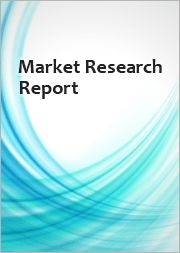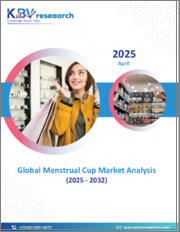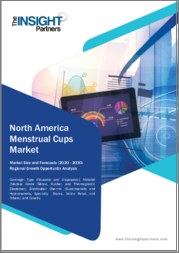
|
시장보고서
상품코드
1472977
생리컵 시장 평가 : 소재 유형, 컵 형상, 사이즈, 가격, 유통 채널, 지역별 기회 및 예측(2017-2031년)Menstrual Cup Market Assessment, By Material Type, By Cup Shape, By Size, By Price, By Distribution Channel, By Region, Opportunities and Forecast, 2017-2031F |
||||||
세계의 생리컵 시장 규모는 2023년 10억 5,187만 달러에서 2024-2031년의 예측 기간 중 5.74%의 CAGR로 추이하며, 2031년에는 16억 4,390만 달러 규모로 성장할 것으로 예측됩니다.
생리 주기를 맞이하는 여성 인구 증가, 개인 위생에 대한 인식 증가, 여성의 역할 다양화, 다른 대체품에 대한 생리컵의 대체 등으로 인해 시장 성장이 예상됩니다.
생리컵 판매 증가의 주요 원인 중 하나는 플라스틱 폐기물 감소를 통한 지속가능성 목표 달성 및 환경 복지 장려입니다. 세계보건기구(WHO)의 수석 과학자에 따르면 생리컵은 생리대 대비 99%의 비생분해성 폐기물을 줄일 수 있다고 합니다.
월경 관련 폐기물을 줄여 시장을 촉진하는 방법:
일반적으로 여성이 일생 동안 사용하는 생리대는 약 10,000-15,000개, 탐폰은 약 9,100개이며, 평균 456회 생리 주기에 약 135kg의 생리 관련 폐기물이 발생합니다. 생리대에는 90%의 플라스틱이 포함되어 있으므로 생리대가 완전히 폐기되기까지 800년이 걸립니다. 일반적으로 이러한 제품은 가정 쓰레기와 함께 버려져 부적절한 쓰레기 처리로 이어집니다. 따라서 환경에 큰 해를 끼치고 있습니다. 아마도 생리컵의 수명은 보통 6-10년 정도이며, 9개의 생리컵으로 충분하기 때문에 생리컵 시장의 추세는 점점 더 커지고 있습니다.
생리 중 유연성이 수요를 주도한다. :
생리컵은 누출이나 불쾌한 상황에 대한 걱정 없이 여성에게 활동적인 유연성을 제공합니다. 컵이 안쪽으로 밀착되어 악취 문제를 효과적으로 해결할 수 있습니다. 생리컵은 6-8시간 동안 착용해도 답답함을 느끼지 않습니다. 이는 월경 건강에 대한 긍정적인 태도로 이어져 월경 컵 시장의 성장으로 이어졌습니다.
또한 인체공학적 모양의 생리컵은 여성들 사이에서 수요가 많습니다. 이러한 컵은 줄기에 쉽게 닿을 수 있도록 설계되어 보다 편안한 착용감을 제공합니다.
실리콘이 가장 큰 시장 점유율을 차지합니다.
재료 유형별로는 실리콘 소재가 시장을 장악할 것으로 예상됩니다. 가이드라인에 따르면 의료용 실리콘은 생리컵 제조에 가장 효과적인 소재입니다. 의료용 실리콘은 재사용이 가능하고, 편안하고, 자극이 없고, 흡수성이 없으며, 생체 적합성이 있습니다. 실리콘으로 만든 생리컵은 인체에 무해하고 알레르기가 적어 지속적으로 사용할 수 있습니다. 유연하고 삽입시 조직 손상을 방지합니다.
세계의 생리컵 시장을 조사했으며, 시장의 정의와 개요, 시장 규모의 추이·예측, 각종 구분·지역별 상세 분석, 산업 구조, 시장 성장에 대한 영향요인의 분석, 사례 연구, 경쟁 구도, 주요 기업의 개요 등을 정리하여 전해드립니다.
목차
제1장 조사 방법
제2장 프로젝트의 범위와 정의
제3장 주요 요약
제4장 고객의 소리
제5장 세계의 생리컵 시장 전망
- 시장 규모·예측
- 소재 유형별
- 실리콘
- 열가소성 엘라스토머
- 기타
- 컵 형상별
- 벨형 컵
- V자 컵
- 환형 컵
- 인간공학에 기반한 형상 컵
- 사이즈별
- 소
- 중
- 대
- 가격순서
- 50달러 이하
- 50-100달러
- 100-200달러
- 200달러 이상
- 유통 채널별
- 오프라인
- 온라인
- 지역별
- 북미
- 유럽
- 아시아태평양
- 남미
- 중동 및 아프리카
- 기업별 시장 점유율
제6장 세계의 생리컵 시장 전망 : 지역별
- 북미
- 유럽
- 아시아태평양
- 남미
- 중동 및 아프리카
제7장 시장 매핑
- 소재 유형별
- 사이즈별
- 가격순서
- 지역별
제8장 거시환경과 산업 구조
- 수급 분석
- 수출입 분석
- 밸류체인 분석
- PESTEL 분석
- Porter's Five Forces 분석
제9장 시장 역학
- 성장 촉진요인
- 성장 억제요인(과제, 억제요인)
제10장 주요 기업의 상황
- 시장 리더 상위 5사의 경쟁 매트릭스
- 시장 리더 상위 5사의 시장 매출 분석
- M&A·조인트 벤처(해당하는 경우)
- SWOT 분석(참여 5사)
- 특허 분석(해당하는 경우)
제11장 가격 분석
제12장 사례 연구
제13장 주요 기업의 전망
- The Flex Company
- Me Luna GmbH
- Diva International Inc.
- LYV Life, Inc.(Cora)
- Saalt LLC
- LELOi AB(Intimina)
- Lena Cup LLC
- Mooncup Ltd
- The Good Glamm Group(Sirona)
- Allmatters ApS
- Procter & Gamble Company(Tampax)
- Redcliffe Hygiene Private Limited(Pee Safe)
제14장 전략적 제안
제15장 Market Xcel - Markets and Data 소개·면책사항
KSA 24.05.10Global menstrual cup market is expected to rise from USD 1051.87 million in 2023 to USD 1643.9 million in 2031, with a projected CAGR of 5.74% during the forecast period, 2024-2031. The market is expected to grow due to the rising population of women who undergo menstrual cycles, increasing awareness for personal hygiene, diversifying roles of women, and substitution of menstrual cups over other alternatives.
Menstrual cups are reusable products used for feminine hygiene, made from safe medical grade material, which provide flexibility and comfort to women during their period-flow days. Menstrual Cups come with a protective primary packaging. They are available in aesthetic and colorful packs to promote product attractiveness and brand recognition. According to the menstrual cup guidelines provided by UNFPA, UNICEF, and UNHCR, the product should accompany instructions for usage, storage, and maintenance. The manufacturer must adhere to the safety standards and compliance related to the use of chemicals and materials mentioned by the authorized regulator.
One of the major causes of increasing sales of menstrual cups is encouraging environmental welfare to reach sustainability goals by reducing plastic waste. According to a chief scientist of World Health Organization, menstrual cups reduce 99% non-biodegradable waste when compared with sanitary napkins.
Overall, menstrual cups are said to be the most environmentally safe and long-term products, which reduce costs, visits to pharmacies, odor, and period-mess due to longer wearability and sustaining healthy vaginal pH. Also, they are a great solution to global issues such as period poverty and the right to decent health related to menstrual blood and the female body.
Mitigation of Menstrual Waste to Promote the Market
Typically, a female uses around 10000-15000 sanitary pads or 9100 tampons in her lifetime, it adds to approx. 135 kg of menstrual waste, averaging 456 period cycles. It takes up to 800 years for a dispose of sanitary pad completely as it contains 90% of plastic. Generally, these products are thrown along with household waste, which leads to improper waste disposal. It in turn contributes to waste water production and marine litter, causing a significant harm to the environment. Perhaps, a menstrual cup usually has a span of 6-10 years, providing a better comparison with around 9 menstrual cups against the high number of alternative products is rising the trend of menstrual cup market.
In the campaign 'ReuseKaroSaveKaro', by The Good Glamm Group's brand, Sirona highlighted the issue of menstrual waste on World Environment Day, 2023 in India. The brand aimed to encourage women to use menstrual cup-like products to reduce waste, urging towards more ecological choice-making. The campaign was held online and offline to increase participation and its outcome. Consequently, the company, backed by the brand, doubled its overall revenue by the end of the financial year 2024.
Flexibility During Menstruation to Drive the Demand
Menstruation is natural to a female body. A woman undergoes a menstrual bleeding of approximately 2-7 days, which leads to constraints in daily tasks and normalcy. Menstrual cups provide women the flexibility of activeness without worrying about leakage or uncomfortable situation. As the cup fits inside, the issues related to foul odors are addressed efficiently. Menstrual cups remove the awkwardness of stuffiness, even when worn for 6-8 hours. It leads to a positive attitude towards menstrual health, leading to the growth of the menstrual cup market. Moreover, menstrual cups are effective while swimming, yoga, or during intercourse, which is not the case with other alternatives.
In addition, menstrual cups with ergonomic shapes are in demand amongst females. These cups have easily accessible stems and design leading to more comfortable fit. For instance, Kind Cup, a brand of Wevatopia LLC, provides its patented curvature shaped cup that has flexible stem and up to 12 hours of wear. Furthermore, Lena Cup LLC launched Lena Cup Generation 3 in April 2023, made with softer silicone and with an ergonomic shape.
Silicone to Hold the Largest Market Share
Silicone material for menstrual cup manufacturing is expected to dominate the market. According to the guidelines, medical-grade silicone is the most effective material for menstrual cup production. Medical-grade silicone is reusable, comfortable, non-irritating, non-absorbing, and biocompatible. Menstrual cups made from silicone are non-toxic to the body and hypoallergic to ensure persistent use. They provide flexibility and prevent tissue damage when inserted. In 2022, Mooncup Ltd. launched its first silicone-made menstrual cup that provides a comfortable experience to the user with trimmable stem and measurement markings.
Other materials used for making menstrual cup are thermoplastic elastomer, ordinary silicone, natural rubber, and latex. Thermoplastic elastomers, however, more environment-friendly, do not have a longer span in comparison of medical grade silicone. Also, most of the key players use silicone material of manufacturing because women possess allergies to latex or rubber. If the product is not completely silicone-based, the risk of presence of plastics remains as an issue.
According to an article in Business Standard, Action Research and Training for Health reported silicone menstrual cup do not break into microplastics, hence, are considered as safe for environment as well as human body.
North America to Dominate the Market
North America is expected to dominate the global menstrual cup market. The region consists of countries, such as United States, which ranks amongst the highest disposable income. According to OECD, 67% of people between 15-64 years and 62% of women have paid jobs. High quality of living further encourages women to spend on personal care products, such as menstrual cups, leading to dominance in the market. Also, the role of women is diversifying with more outdoors participations, resulting into the rise in demand for safer and prolonging menstrual solutions. Hence, menstrual cups are considered to be safer due to eight to twelve hours of control, with flexibility and comfort, contributing to the global menstrual cups market.
Moreover, Asia-Pacific, being the fastest growing region in the world, is expected to gain higher share in the menstrual cups market during the forecast period. According to the World Bank, India has the highest number of females between 15-64 years, with around 463.28 million women, growing at a CAGR of around 1%, annually, followed by China. Increasing working women and availability of different shapes and material of menstrual cups in the region are expected to drive the size of the Asia-Pacific menstrual cup market.
Future Market Scenario
More ergonomic designs to gain popularity as there is an increase in women who are active outdoors and demand safer menstrual cups without any leakage.
AI and IoT-based menstrual cups are expected to gain popularity due to technological environment and increasing consciousness towards menstrual health monitoring. An example of such product is Emm Smart menstrual cup, launched in 2023. The cup is integrated with an application that monitors blood and cycle related data of the user.
Key Players Landscape and Outlook
The outlook of global menstrual cup market looks positive, when considered from the perspective of environment and menstrual health. Organizations such as WECF and WASH are dedicatedly working to spread awareness regarding menstrual cup usage. National and international regulations promote sales and distribution. In addition, the key players are creating more awareness through online and offline social campaigns. It promotes their sales leading to corporate social responsibility and increasing brand image.
For instance, in January 2023, HLL Healthcare launched three brands, Thinkal, Velvet, and Cool Cup, in alliance with the government of India. During the event, the company distributed menstrual cups to lower and middle-class populations, leading to awareness and period care.
Table of Contents
1.Research Methodology
2.Project Scope & Definitions
3.Executive Summary
4.Voice of Customer
5.Global Menstrual Cup Market Outlook, 2017-2031F
- 5.1.Market Size & Forecast
- 5.1.1.By Value
- 5.1.2.By Volume
- 5.2.By Material Type
- 5.2.1.Silicone
- 5.2.2.Thermoplastic Elastomer
- 5.2.3.Others
- 5.3.By Cup Shape
- 5.3.1.Bell-Shaped Cups
- 5.3.2.V-Shaped Cups
- 5.3.3.Round-Shaped Cups
- 5.3.4.Ergonomic Shaped Cups
- 5.4.By Size
- 5.4.1.Small
- 5.4.2.Medium
- 5.4.3.Large
- 5.5.By Price
- 5.5.1.Below USD 50
- 5.5.2.USD 50- USD 100
- 5.5.3.USD 100- USD 200
- 5.5.4.Above USD 200
- 5.6.By Distribution Channel
- 5.6.1.Offline
- 5.6.1.1.Departmental Stores
- 5.6.1.2.Pharmacies
- 5.6.1.3.Others
- 5.6.2.Online
- 5.6.2.1.Store Websites
- 5.6.2.2.Marketplace Shopping
- 5.6.1.Offline
- 5.7.By Region
- 5.7.1.North America
- 5.7.2.Europe
- 5.7.3.Asia-Pacific
- 5.7.4.South America
- 5.7.5.Middle East and Africa
- 5.8.By Company Market Share (%), 2023
6.Global Menstrual Cup Market Outlook, By Region, 2017-2031F
- 6.1.North America
- 6.1.1.Market Size & Forecast
- 6.1.1.1.By Value
- 6.1.1.2.By Volume
- 6.1.2.By Material Type
- 6.1.2.1.Silicone
- 6.1.2.2.Thermoplastic Elastomer
- 6.1.2.3.Others
- 6.1.3.By Cup Shape
- 6.1.3.1.Bell-Shaped Cups
- 6.1.3.2.V-Shaped Cups
- 6.1.3.3.Round-Shaped Cups
- 6.1.3.4.Ergonomic Shaped Cups
- 6.1.4.By Size
- 6.1.4.1.Small
- 6.1.4.2.Medium
- 6.1.4.3.Large
- 6.1.5.By Price
- 6.1.5.1.Below USD 50
- 6.1.5.2.USD 50- USD 100
- 6.1.5.3.USD 100- USD 200
- 6.1.5.4.Above USD 200
- 6.1.6.By Distribution Channel
- 6.1.6.1.Offline
- 6.1.6.1.1.Departmental Stores
- 6.1.6.1.2.Pharmacies
- 6.1.6.1.3.Others
- 6.1.6.2.Online
- 6.1.6.2.1.Store Websites
- 6.1.6.2.2.Marketplace Shopping
- 6.1.6.1.Offline
- 6.1.7.United States*
- 6.1.7.1.Market Size & Forecast
- 6.1.7.1.1.By Value
- 6.1.7.1.2.By Volume
- 6.1.7.2.By Material Type
- 6.1.7.2.1.Silicone
- 6.1.7.2.2.Thermoplastic Elastomer
- 6.1.7.2.3.Others
- 6.1.7.3.By Cup Shape
- 6.1.7.3.1.Bell-Shaped Cups
- 6.1.7.3.2.V-Shaped Cups
- 6.1.7.3.3.Round-Shaped Cups
- 6.1.7.3.4.Ergonomic Shaped Cups
- 6.1.7.4.By Size
- 6.1.7.4.1.Small
- 6.1.7.4.2.Medium
- 6.1.7.4.3.Large
- 6.1.7.5.By Price
- 6.1.7.5.1.Below USD 50
- 6.1.7.5.2.USD 50- USD 100
- 6.1.7.5.3.USD 100- USD 200
- 6.1.7.5.4.Above USD 200
- 6.1.7.6.By Distribution Channel
- 6.1.7.6.1.Offline
- 6.1.7.6.1.1.Departmental Stores
- 6.1.7.6.1.2.Pharmacies
- 6.1.7.6.1.3.Others
- 6.1.7.6.2.Online
- 6.1.7.6.2.1.Store Websites
- 6.1.7.6.2.2.Marketplace Shopping
- 6.1.7.6.1.Offline
- 6.1.7.1.Market Size & Forecast
- 6.1.8.Canada
- 6.1.9.Mexico
- 6.1.1.Market Size & Forecast
All segments will be provided for all regions and countries covered
- 6.2.Europe
- 6.2.1.Germany
- 6.2.2.France
- 6.2.3.Italy
- 6.2.4.United Kingdom
- 6.2.5.Russia
- 6.2.6.Netherlands
- 6.2.7.Spain
- 6.2.8.Turkey
- 6.2.9.Poland
- 6.3.Asia-Pacific
- 6.3.1.India
- 6.3.2.China
- 6.3.3.Japan
- 6.3.4.Australia
- 6.3.5.Vietnam
- 6.3.6.South Korea
- 6.3.7.Indonesia
- 6.3.8.Philippines
- 6.4.South America
- 6.4.1.Brazil
- 6.4.2.Argentina
- 6.5.Middle East & Africa
- 6.5.1.Saudi Arabia
- 6.5.2.UAE
- 6.5.3.South Africa
7.Market Mapping, 2023
- 7.1.By Material Type
- 7.2.By Size
- 7.3.By Price
- 7.4.By Region
8.Macro Environment and Industry Structure
- 8.1.Demand Supply Analysis
- 8.2.Import Export Analysis
- 8.3.Value Chain Analysis
- 8.4.PESTEL Analysis
- 8.4.1.Political Factors
- 8.4.2.Economic System
- 8.4.3.Social Implications
- 8.4.4.Technological Advancements
- 8.4.5.Environmental Impacts
- 8.4.6.Legal Compliances and Regulatory Policies (Statutory Bodies Included)
- 8.5.Porter's Five Forces Analysis
- 8.5.1.Supplier Power
- 8.5.2.Buyer Power
- 8.5.3.Substitution Threat
- 8.5.4.Threat from New Entrant
- 8.5.5.Competitive Rivalry
9.Market Dynamics
- 9.1.Growth Drivers
- 9.2.Growth Inhibitors (Challenges and Restraints)
10.Key Players Landscape
- 10.1.Competition Matrix of Top Five Market Leaders
- 10.2.Market Revenue Analysis of Top Five Market Leaders (in %, 2023)
- 10.3.Mergers and Acquisitions/Joint Ventures (If Applicable)
- 10.4.SWOT Analysis (For Five Market Players)
- 10.5.Patent Analysis (If Applicable)
11.Pricing Analysis
12.Case Studies
13.Key Players Outlook
- 13.1.The Flex Company
- 13.1.1.Company Details
- 13.1.2.Key Management Personnel
- 13.1.3.Products & Services
- 13.1.4.Financials (As reported)
- 13.1.5.Key Market Focus & Geographical Presence
- 13.1.6.Recent Developments
- 13.2.Me Luna GmbH
- 13.3.Diva International Inc.
- 13.4.LYV Life, Inc. (Cora)
- 13.5.Saalt LLC
- 13.6.LELOi AB (Intimina)
- 13.7.Lena Cup LLC
- 13.8.Mooncup Ltd
- 13.9.The Good Glamm Group (Sirona)
- 13.10.Allmatters ApS
- 13.11.Procter & Gamble Company (Tampax)
- 13.12.Redcliffe Hygiene Private Limited (Pee Safe)
Companies mentioned above DO NOT hold any order as per market share and can be changed as per information available during research work.



















